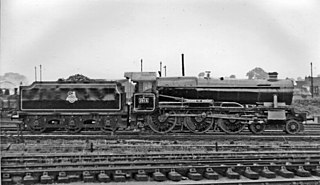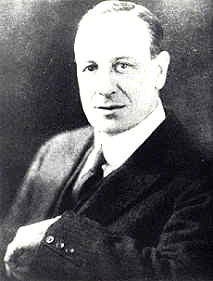The London, Midland and Scottish Railway had the largest stock of steam locomotives of any of the 'Big Four' Grouping, i.e. pre-Nationalisation railway companies in the UK. Despite early troubles arising from factions within the new company, the LMS went on to build some very successful designs; many lasted until the end of steam traction on British Railways in 1968. For an explanation of numbering and classification, see British Rail locomotive and multiple unit numbering and classification.

The London Midland and Scottish Railway (LMS) Jubilee Class is a class of steam locomotive designed for main line passenger work. 191 locomotives were built between 1934 and 1936. They were built concurrently with the similar looking LMS Stanier Class 5 4-6-0. They were nicknamed Red Staniers and Jubs.

The London, Midland and Scottish Railway Fowler Class 7F was a class of 0-8-0 steam locomotives. They were a Midlandised version of the London and North Western Railway (LNWR) Class G2 and Class G2A 0-8-0s. They were also classified as Class G3 under the former LNWR system. The class were sometimes known as Baby Austins, or Austin 7s, after a motor car that was becoming popular at the time.

The London, Midland and Scottish Railway (LMS) Stanier Class 5 4-6-0, commonly known as the Black Five, is a class of 4-6-0 steam locomotives. It was introduced by William Stanier and built between 1934 and 1951, of which 842 were built and were numbered 4658-5499. Several members of the class survived to the last day of steam on British Railways in 1968, and eighteen are preserved.

The Patriot Class was a class of 52 express passenger steam locomotives built for the London Midland and Scottish Railway. The first locomotive of the class was built in 1930 and the last in 1934. The class was based on the chassis of the Royal Scot combined with the boiler from Large Claughtons earning them the nickname Baby Scots. A total of 18 were rebuilt to create the LMS Rebuilt Patriot Class between 1946 and 1948; thereafter those not subjected to rebuilding were often referred to as the Unrebuilt Patriot Class. These remaining 34 unrebuilt engines were withdrawn between 1960 and 1962.

The London Midland and Scottish Railway (LMS) Stanier Class 5 2-6-0 or Stanier Mogul is a class of 2-6-0 mixed traffic steam locomotives. Forty were built between October 1933 and March 1934.

The London Midland and Scottish Railway (LMS) Hughes Crab or Horwich Mogul is a class of mixed-traffic 2-6-0 steam locomotive built between 1926 and 1932. They are noted for their appearance with large steeply-angled cylinders to accommodate a restricted loading gauge.

The London, Midland and Scottish Railway (LMS) Garratt was a class of Garratt 2-6-0+0-6-2 steam locomotive designed for heavy freight. A total of 33 were built from 1927, making them the most numerous class of Garratt in Britain.

The London, Midland and Scottish Railway (LMS) Stanier Class 2 0-4-4T was a class of 10 light passenger locomotives built in 1932. Ostensibly designed under new Chief Mechanical Engineer (CME) William Stanier, they were in fact the last new design of the Midland Railway's school of engineering.

The London, Midland and Scottish Railway (LMS) Fowler 2-6-2T was a class of steam locomotive. The LMS classified them 3P, BR 3MT. All were built at Derby Works between 1930 and 1932. William Stanier used them to form the basis for the LMS Stanier 2-6-2T, which was essentially a taper boilered version.

The London, Midland and Scottish Railway (LMS) Fowler 2-6-4T was a class of steam locomotive passenger tank engine designed by Henry Fowler.

The Great Western Railway 1000 Class or County Class was a class of 4-6-0 steam locomotive. Thirty examples were built between 1945 and 1947, but all were withdrawn and scrapped in the early 1960s. A replica locomotive is under construction.

The London, Midland and Scottish Railway (LMS) Fowler 3F0-6-0T is a class of steam locomotives, often known as Jinty. They represent the ultimate development of the Midland Railway's six-coupled tank engines. They could reach speeds of up to 60 mph (97 km/h).

Charles Benjamin Collett was Chief Mechanical Engineer of the Great Western Railway from 1922 to 1941. He designed the GWR's 4-6-0 Castle and King Class express passenger locomotives.

The London, Midland and Scottish Railway (LMS) 6170British Legion was a British steam locomotive. It was the prototype for, and is sometimes considered a member of, the Rebuilt Royal Scot Class but differed from those later rebuilds principally in having a unique type 2 boiler, rather than a type 2A boiler, the two not being interchangeable.

The NCC Class WT is a class of 2-6-4T steam locomotives built by the Northern Counties Committee's parent company, the London, Midland and Scottish Railway for service in Northern Ireland.

The Northern Counties Committee (NCC) Class U2 4-4-0 passenger steam locomotives consisted of 18 locomotives built for service in north-east Ireland. Ten of the engines were new builds supplied by the North British Locomotive Company (NBL) or constructed at the NCC's York Road works. The remainder were rebuilds of existing locomotives.
The London and North Eastern Railway (LNER) Class O6 was a class of 2-8-0 steam locomotives of the Stanier Class 8F type.

The London Midland and Scottish Railway (LMS), Rebuilt Patriot Class was a class of 4-6-0 steam locomotives. They were rebuilt from LMS Patriot Class locomotives over the period 1946–1949. By the end of 1947, the LMS had rebuilt seven engines, these being 5514/21/26/29–31/40. After nationalisation, a further eleven locomotives were rebuilt. Rebuilt locomotives retained their numbers.

A double chimney is a form of chimney for a steam locomotive, where the conventional single opening is duplicated, together with the blastpipe beneath it. Although the internal openings form two circles, the outside appearance is as a single elongated oval.




















